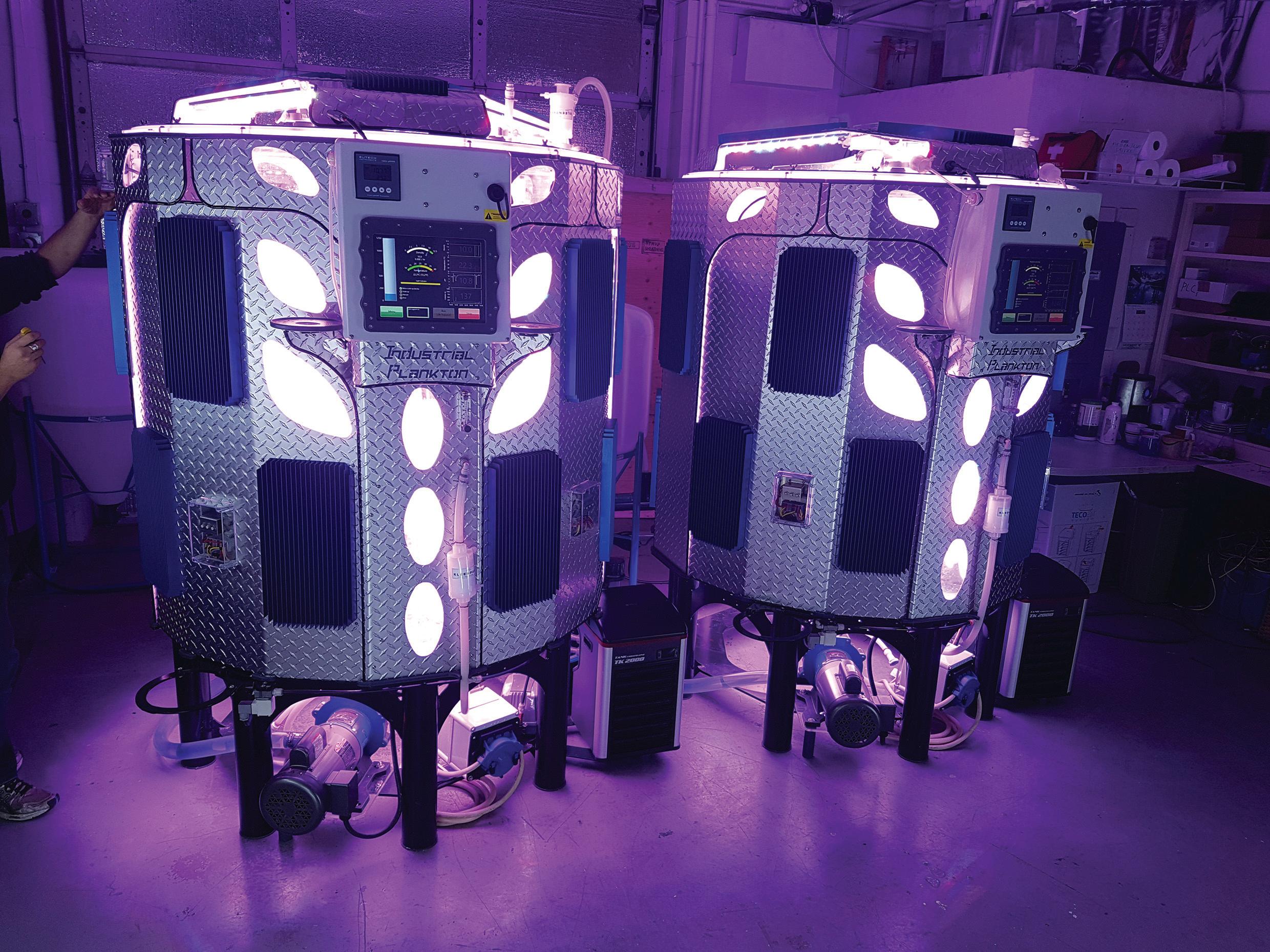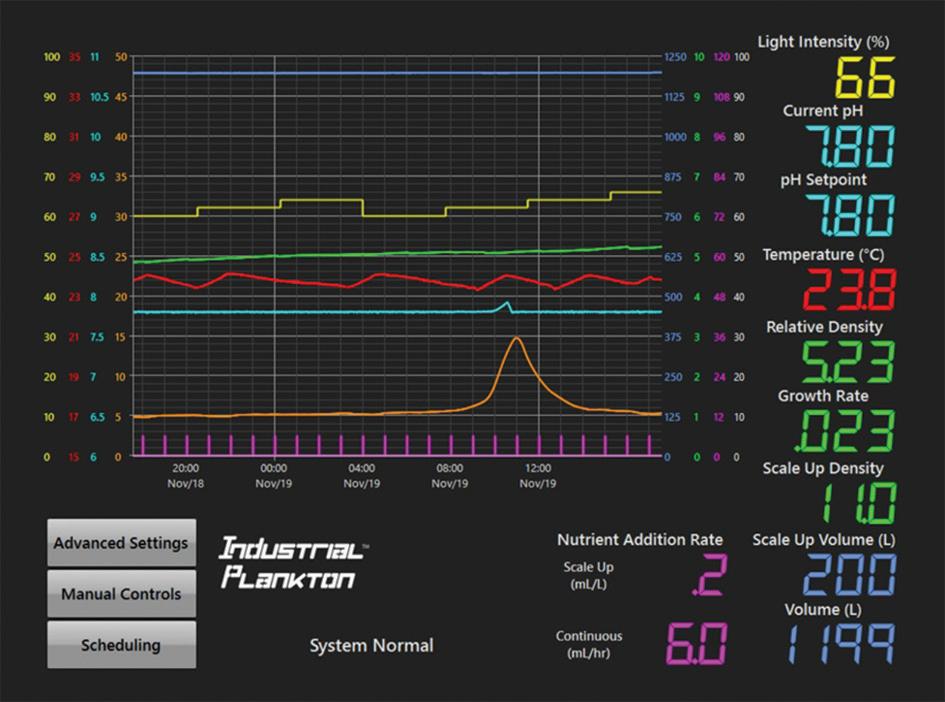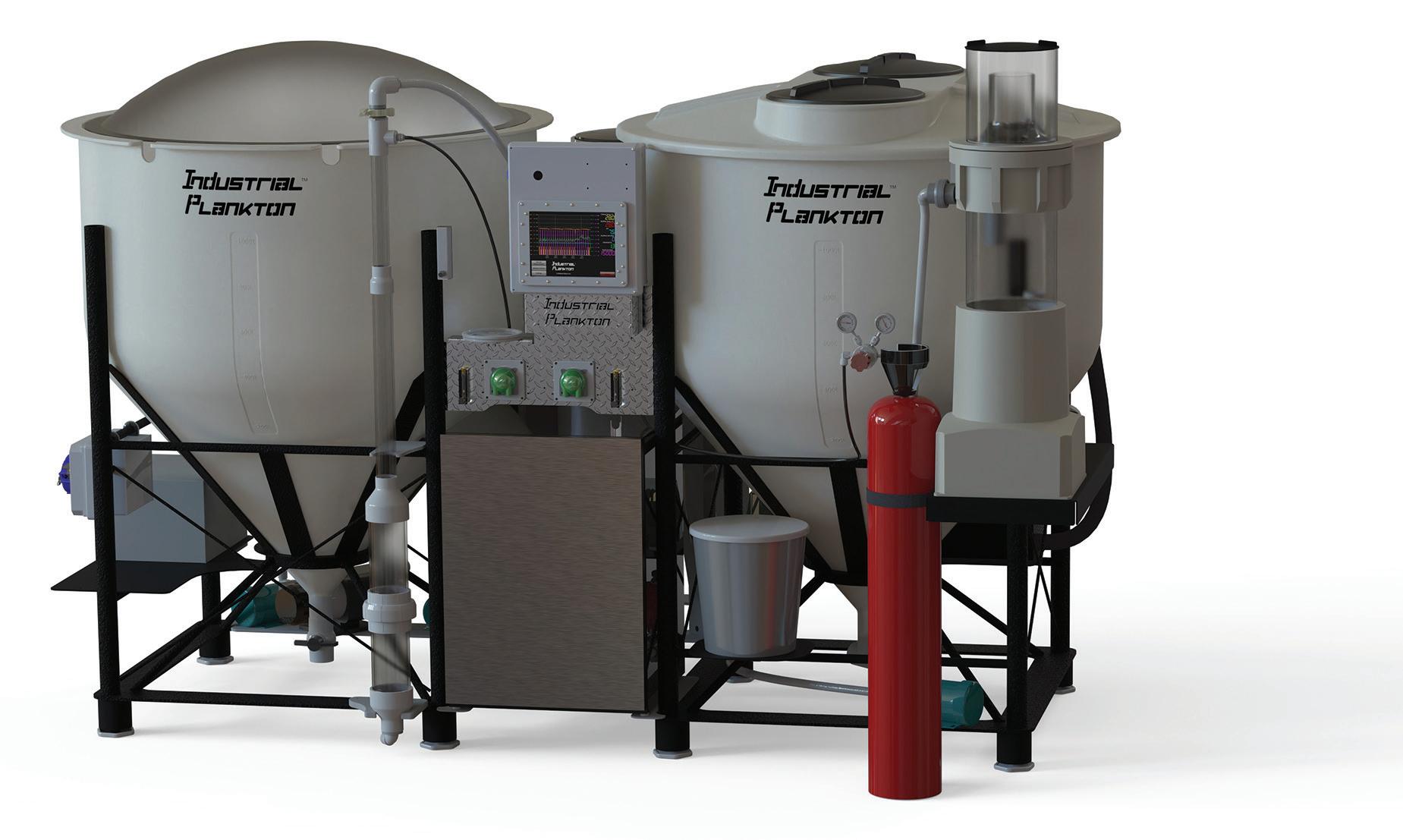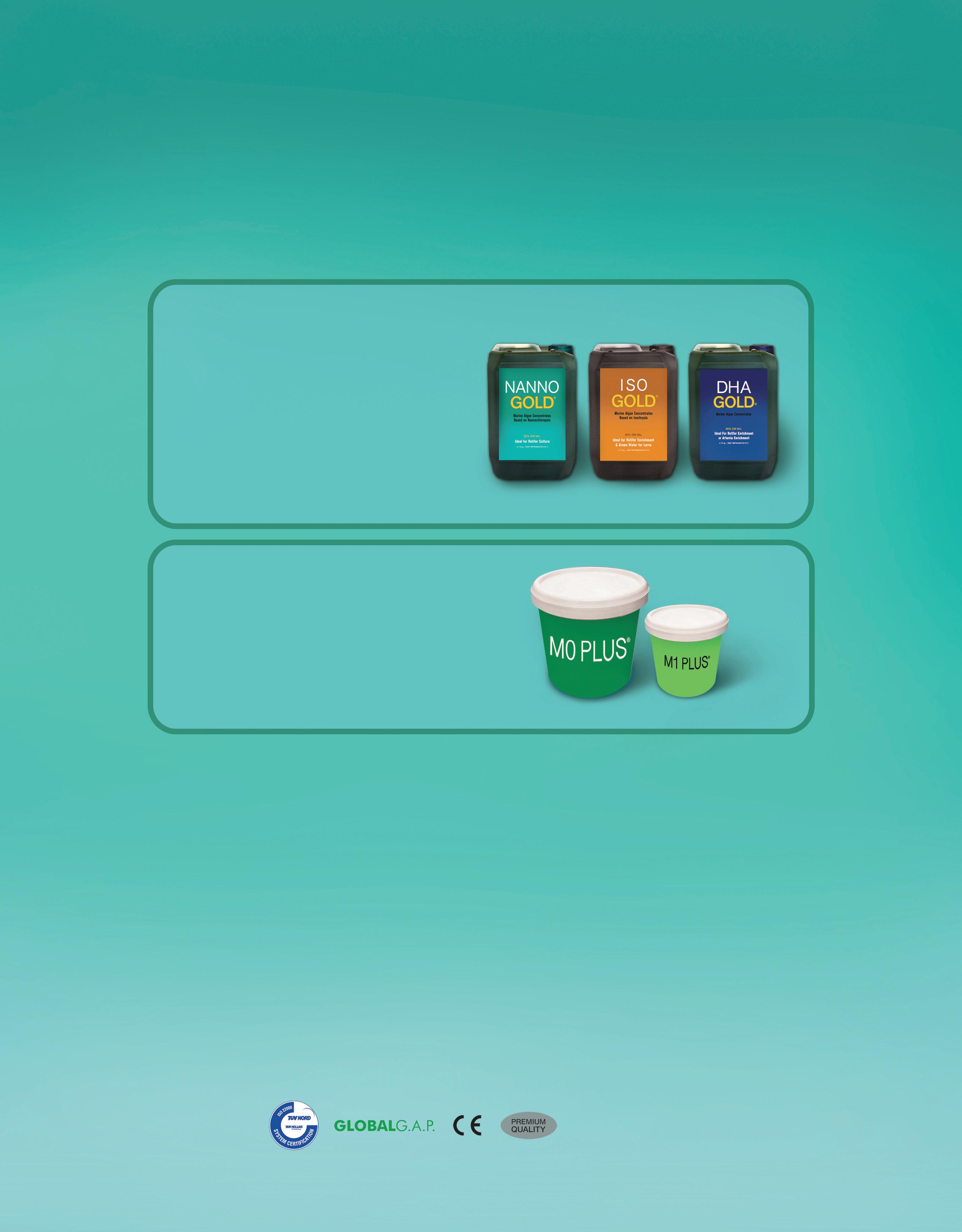
10 minute read
Automated bioreactors for live feeds
Figure 1. PBR 1250L.
Reliably producing enough live feed is the bottleneck for many shellfish, shrimp and marine finfish hatcheries. The feed has to be of good quality with both high nutrition levels and low pathogen levels. Without enough feed, animals starve or are underfed. When operating a hatchery, operators have probably calculated the cost of this loss and weighed it against the live feed’s production cost.
The true cost of poor-quality live feeds is often given less attention, since it’s usually impossible to calculate the impact on the entire value chain. Live feeds are
commonly contaminated with pathogens that increase the mortality of hatchery animals, or even kill the entire cohort. Animals that do survive by fighting off early infections often have less efficient feed conversion ratios and lower growth rates, often resulting in a lower yield in the grow-out phase.
To help solve these problems with reliable production and feed quality, Industrial Plankton has developed live feed equipment for producing algae and zooplankton with a focus on maintaining a stable biosecure culture environment.
Figure 2. Nannochloropsis oculata culture in continuous harvest. Here, the CO 2 supply was shut off. The resulting pH spike was easy to spot and fix before the pH got too high.

Algae Consistently producing algae on site can be time consuming and unreliable. By maintaining a clean, stable culture environment and automating many routine functions, Industrial Plankton photobioreactors (Fig. 1) make it easy to consistently produce algae to meet hatchery needs.
Biosecurity A big challenge to producing clean algae outside a lab is biosecurity. A single grazer or pathogenic bacteria can invade a culture and establish a population, causing reduced productivity or larval mortality. To establish a clean culture environment, the PBR 1250L uses an automated clean-in-place (CIP) system to clean and disinfect the tank before starting a new culture. Additionally, the bioreactor has micron filters to maintain biosecurity while adding the water, nutrients, air and CO 2 . To start a new culture, the inoculum is connected to the PBR with sterile disconnects, then pumped in with a biosecure pump. By maintaining biosecurity, a PBR can continuously produce high quality clean algae for months.
Reliability through automation After inoculation, the next step is providing the right temperature and the amount of nutrients, CO 2 , and light needed to sustain production and prevent culture crashes. To minimize time and effort, the PBR 1250L automates these functions. Nutrients are stirred and added automatically and closed loop pH control adds CO 2 as the algae grows, maintaining constant pH and preventing carbon limitation. Harvesting can be done with the push of a button, scheduled to harvest automatically, or set to harvest continuously. Temperature is controlled using a chiller and an internal heat exchanger. As long as the PBR has a supply of water, CO 2 and nutrients, it can produce algae automatically.
A touchscreen control makes it easy to adjust settings. The controls also log and graph the sensor data, simplifying troubleshooting (Fig. 2).
Cleaning One of the most unreliable and labor-intensive tasks required for culturing algae is cleaning tanks. By providing a self-cleaning biosecure tank, algae cultures can grow productively for longer. When a tank needs to be cleaned, the PBR 1250L’s automatic cleaning system removes the need for manual cleaning, working like a dishwasher to pressure wash the inside of the tank.
Cell density When culturing algae, it’s important to quantify algae biomass. However, counting algae cells on a microscope is time consuming and requires technical skills. To reduce the need for manual cell counts, the PBR 1250L uses a density sensor to output a linearized 0-10 value (Fig. 2, in green). This real-time density feedback helps operators maximize productivity by seeing the effect of changing light, nutrient additions, harvest rate, etc.
Rotifers Rotifers are a critical first food for many larval fish but are labor intensive to produce, and are a common source of Vibrio and other pathogens.
Biosecurity Most rotifer production is still done in batch systems. The problem with batch production is lack of control over the bacterial population. Vibro is often present in rotifer cultures or introduced with incoming water, so operators are often scaling up a batch of Vibrio along with the batch of rotifers.
Figure 3. Industrial Plankton rotifer system.
In a stable environment without excess organic waste, pathogenic bacteria can be kept in check. If system parameters are unstable, the fluctuating organic load can allow faster growing pathogenic bacteria to rapidly increase in numbers. In a stable system, the bacterial population becomes dominated by beneficial heterotrophic bacteria.
The constant removal of organic waste from the culture is also critical, since high levels of organic waste generally encourages growth of opportunistic bacteria.
Reliability through automation To reduce levels of pathogens in the culture, the Industrial Plankton Rotifer System (Fig. 3) operates as a continuously recirculating system with an attached biofilter. This provides a stable culture environment rich in beneficial bacteria, preventing opportunistic pathogenic bacteria from proliferating.
The rotifer system uses a touchscreen interface to display and log data, and controls vital parameters such as temperature, pH, and dissolved oxygen. To maintain good water quality, organic waste is removed using a self-cleaning mechanical filter, a foam fractionator, and finally a biofilter to detoxify ammonia.

Conclusion Live feeds produced from Industrial Plankton’s automated equipment are a perfect solution to the bottleneck experienced by many shellfish, shrimp and marine finfish hatcheries. The reliable production of high-quality live feed in a stable biosecure culture environment allows for improved nutrition and lower chances of early infections in animals, resulting in higher hatchery survival and growth rates. The equipment is currently operating in 18 countries to support the hatchery production of oysters, mussels, clams, vannamei shrimp, monodon shrimp and marine finfish.
More information: Robert Roulston CEO Industrial Plankton, Canada E: robert@industrialplankton.com
Jennifer Long Biologist Industrial Plankton, Canada E: jennifer@industrialplankton.com

Developments in aquaculture from Aquaculture Ghent University Prof. Dr. Gilbert Van Stappen, Laboratory of Aquaculture & Artemia Reference Center Microbes rule the world – the sequel COLUMN
Previous contributions to this column have highlighted the importance of microorganisms in larviculture practice and in performance of fish and shellfish larvae in the hatchery and in aquaculture in general. So far, “microorganisms” within an aquaculture context were always understood as, firstly, microalgae (see also the green water technique) and, more recently, as bacteria.
It is well-known that all living organisms can be subdivided in two big groups (let’s keep viruses aside for the sake of this exercise), the so-called “domains”. The first ones are the Eukaryotes or – translated from Greek - organisms with “a proper nucleus”, either unicellular (such as microalgae) or multicellular, consisting of cell(s) characterized by, summarizing, a membrane-bound nucleus with the genetic material within, and several intracellular organelles. The second domain are Bacteria, basically, organisms consisting of a single cell lacking (among other differences as compared to Eukaryotes), the typical nucleus. However, only recently it was found that life also presents itself under a third “format” or “Domain”: these are the “Archaea”, a specific group of single-cell organisms. A mouthful of ancient Greek always comes in handy: their name means “ancient beings”, as the first representatives of this group ever studied were methane producing microorganisms. It was assumed that their metabolism reflected the Earth’s primitive atmosphere and that in evolution they thus colonized our planet before the more “modern” bacteria and Eukaryote organisms. However, as new habitats were studied, more of these archaeic organisms were discovered, sometimes living in conditions very hostile for other life forms, such as environments characterized by high salinity or extreme temperatures,
where they survive thanks to very specific physiological adaptations. Although indeed Archaea are often the only form of life (as we know it) found to survive in extreme environments today (hence their qualification as extremophile), they are known to be a large and diverse group of organisms abundantly distributed throughout nature, including even the animal (and human!) gut.
Let’s look at another extremophile: the brine shrimp Artemia, which we all know as a common live food organism in larviculture, thanks to its storable cysts and its nauplii hatching from them. Brine shrimp survive in the very saline conditions of salt ponds and salt lakes where virtually no other multicellular (“higher”) organism or metazoan survives. Although there are just few field studies on this, here Artemia is supposed to live side by side with Archaea that must thus make up for a substantial part of its “associated” microbial environment. The role of microalgae, on the contrary, as food for Artemia, has been investigated in detail, both in the field and in the laboratory. More recently, also the nutritional contribution of bacteria to the Artemia diet has been well documented.
This detour, via the world of extremophiles, brings us back to the role of microorganisms in aquaculture, and to the so-called “microbial management”: in essence, steering the microbial background of aquaculture operations to the advantage of bacteriathat-we-want-to-be-present-and-active, and to the disadvantage of those-that-we-want-to-stay-out (or at least: keeping low profile). If the Archaea are indeed ubiquitous and occur in any aquatic ecosystem, as we know now, is it too far-going to assume that just as any other microorganism, they may interact in various ways with higher organisms, just as microalgae and bacteria do? Can they be food? Can they promote health? (No pathogenic Archaea have been identified until now. So far so good!) Given the fact that Archaea contain a variety of compounds, and have a variety of
processes in place to protect them against their extreme/ stressful environment, one can indeed wonder to what extent they can have a beneficial role when they are eaten by a higher organism – such as Artemia.
The first question to be answered, however, is: can Archaea be taken up at all by higher organisms? The question is not as futile as it seems. One of the characteristics that makes Archaea quite different from the other two domains of life is the chemical structure of their cell membrane lipids, which is quite unique. It is, for example, not known if these very special archaeal cell membranes can be digested at all by the digestive enzymes of Artemia (or other filter feeding organisms), and if archaeal lipids may provide the critical fatty acids that most metazoans need for survival. In fact, it was not before 2012 that one of the very first studies documented the uptake of Archaea by a higher organism, so-called “archivory”: a specific marine polychaete worm species, living in marine methane seeps, seems to be able to assimilate Archaea.
To study interactions between Archaea and higher organisms in more depth, Artemia comes in the picture again: it is an excellent model in studying bacteria-host interactions within an aquaculture context, and the results of these studies have proven highly instrumental in developing techniques and protocols for microbial management. Recent studies at the Laboratory of Aquaculture & Artemia Reference Center of Ghent University, Belgium, have demonstrated that Artemia is able to survive and grow for at least a few days in a laboratory environment in the exclusive presence of Archaea, thus ruling out interference of microalgae, bacteria, or any other food source. Thus, although the “scoop” of documenting archivory has gone to the marine polychaete, Artemia is an honorable second. Moreover, assimilation of archaeal biomass into Artemia biomass was studied in great detail, using the technique of stable isotope (SI) labelling and tracing, a tool frequently used in nutritional studies to study the uptake of organisms by other organisms, tracing the fate of specific microbial dietary components, when taken up by a higher organism. This was the first case ever of using SI labelling for nutritional studies with Archaea: the Archaea labelled with SI, could indeed be traced back in the so-called isotopic “signature” of the Artemia fed with them, proving without any doubt their assimilation into Artemia biomass.
What does all this mean for larviculture and aquaculture in general? We do not operate in extreme conditions, do we? That’s right, but remember that - just like Bacteria - Archaea seem to be everywhere, even within the gut of the reader of this text. Now that the way has been paved (yes, Archaea can be taken up by higher organisms! Yes, we have tools in place to follow their assimilation!) the road is open for further work on microbial management that includes not just microalgae and bacteria, but also Archaea. With these assumedly ancient forms of life, and their contemporary descendants, the “art” of microbial management in aquaculture has acquired a fascinating new dimension, to be further explored in the future.
NEXT ISSUE: Shrimp and crustacean feed Water quality Disease management



Submit editorial: editor@hatcheryfm.com Advertising inquiries: sales@hatcheryfm.com










